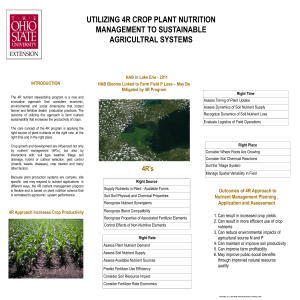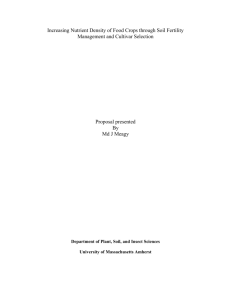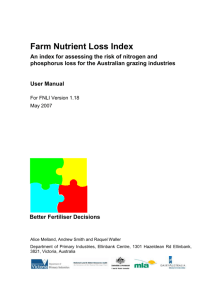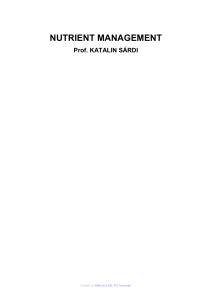Nutrient Management
advertisement
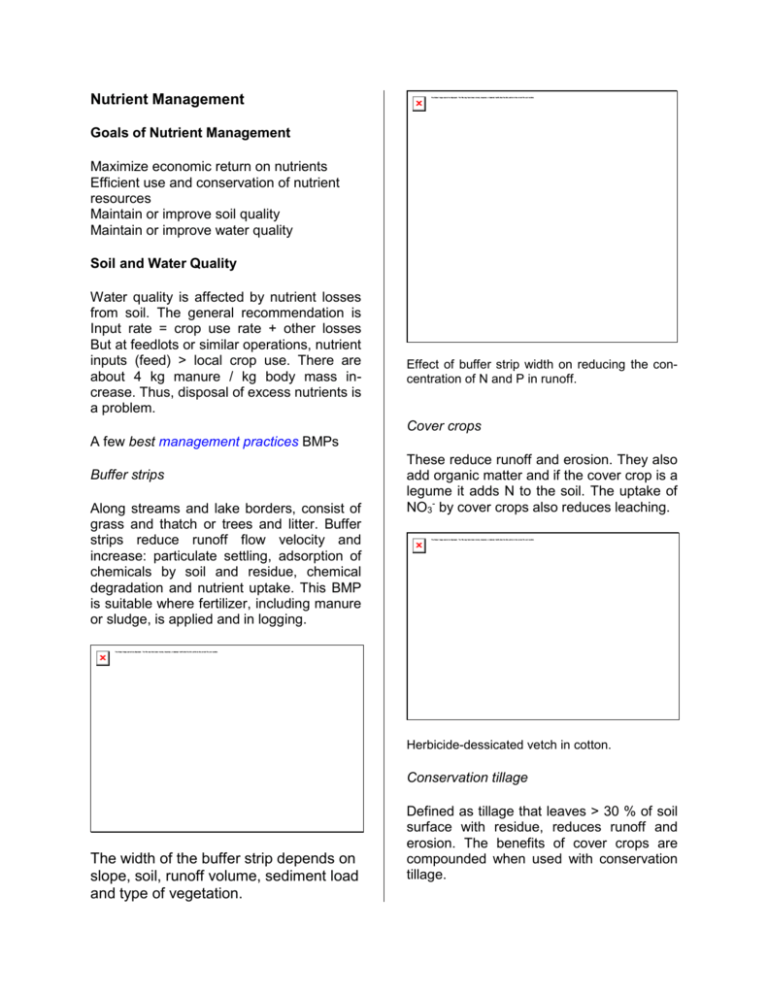
Nutrient Management Goals of Nutrient Management Maximize economic return on nutrients Efficient use and conservation of nutrient resources Maintain or improve soil quality Maintain or improve water quality Soil and Water Quality Water quality is affected by nutrient losses from soil. The general recommendation is Input rate = crop use rate + other losses But at feedlots or similar operations, nutrient inputs (feed) > local crop use. There are about 4 kg manure / kg body mass increase. Thus, disposal of excess nutrients is a problem. Effect of buffer strip width on reducing the concentration of N and P in runoff. Cover crops A few best management practices BMPs Buffer strips Along streams and lake borders, consist of grass and thatch or trees and litter. Buffer strips reduce runoff flow velocity and increase: particulate settling, adsorption of chemicals by soil and residue, chemical degradation and nutrient uptake. This BMP is suitable where fertilizer, including manure or sludge, is applied and in logging. These reduce runoff and erosion. They also add organic matter and if the cover crop is a legume it adds N to the soil. The uptake of NO3- by cover crops also reduces leaching. Herbicide-dessicated vetch in cotton. Conservation tillage The width of the buffer strip depends on slope, soil, runoff volume, sediment load and type of vegetation. Defined as tillage that leaves > 30 % of soil surface with residue, reduces runoff and erosion. The benefits of cover crops are compounded when used with conservation tillage. Crop rotations Break cycles of weeds, disease and insects and provide varied organic residues that encourage microbial diversity. Inclusion of a legume in the rotation adds N. N-depression occurs if these materials are incorporated in the soil without an added source of N. Sewage effluent and sludge In the processing of sewage, biosolids (sludge) settle out and N and P are then removed from effluent. Tertiary treatment of effluent may be irrigation of crops or trees. Sludge can be used as a soil amendment. In some cases it is dried and used as slow release fertilizer. It can also be composted or directly applied as a slurry or wet cake. The content of K is low since it lost in effluent. Also, P availability is low it since precipitated with Al or Fe during treatment to remove it from effluent. Use of Organic Nutrient Sources Effect of incusion of a legume in a corn rotation on corn yields. Rate of application is based on N requirement of crop. Therefore, a relatively high amount of P is added. Most N is not readily available since it is in organic form. Accordingly, one must account for the slow release of N in estimating future application rate. Also, the nutrient composition is variable. Organic Sources of Nutrients Manures Plant nutrient composition is highly variable depending on animal, feed and storage of manure. Typically, N varies from 2 to 5 %; P from ½ to 2 %; and K from 1 to 3 %. The high water content of manure adds cost and hassle its use. Industrial and Municipal Wastes Many industrial wastes are unfit for landapplication due to chemical content. Garbage can be composted to give municipal solid waste (MSW) after glass and metal have been removed. This material, however, has a low nutrient content. Forest products such as sawdust, chips and bark have high C / N ratios. Therefore, these can be used as mulch but In general, the greatest benefits and lowest risks exist if these materials are applied to soils low in N and P. Inorganic and Synthetic Fertilizers There are various carriers (compounds) for each nutrient. Most are water soluble. Unlike organic materials, the nutrient composition of these is known and expressed in the grade of the fertilizer. Grade N-P-K N = % N, P = % P2O5 and K = % K2O Concentrated carriers are usually the most economical due to lower transportation cost. Limiting Factor von Liebig Production is no greater than that level set by the growth factor that is present in lowest amount relative to the optimum amount of that factor (limiting factor). Questions In any soil fertility management program one must consider several questions. What nutrient(s) is needed and in What amount(s) What form (carrier) should be used How should it (these) be applied and When should the fertilizer be applied Plant and soil analyses address the first two questions. Field observations are helpful in the interpretation of plant and soil analyses. For example, one might see spatial patterns in field, like a linear pattern which may indicate a problem due to tillage, fertilizer application and so forth or a problem associated with low or high spots. Foliage may show deficiency symptoms or evidence other damage as due to insects or herbicides. Growth and yield measurements indirectly reveal fertility level. Root growth may show effects of limited nodulation or presence of a hard pan. In using tissue analysis, one must sample the plant part that is the best indicator of deficiency. Timing is also important because tissue concentrations decrease with maturity. An alternative approach uses ratios of elements (N / P, N / K and so forth) rather than critical values. The advantage is that limitations of specific tissue and plant age are overcome, however, this approach is more complicated. Soil Analysis Consists of soil sampling, lab analysis and recommendations based on calibration of soil test values to plant growth and yield. Soil sampling Consider soil spatial variability by dividing a site into management zones and taking several random samples within each from which a single composite sample is submitted for analysis. Of course, one must avoid atypical areas. Plant Analysis Examines the relationship between concentration of essential elements in plant tissue and growth. Deficiency symptoms occur if availability very low. However, there can be reduced growth without deficiency symptoms, reflecting hidden hunger. Plant analysis seeks to identify critical concentrations below which growth and yield are suboptimal. The sufficiency range for macronutrients is relatively wide and includes luxury consumption. Beyond the sufficiency range concentrations of essential elements may be toxic, from slight to lethal. Example sampling strategies. Laboratory chemical analysis Localized placement Soil is extracted with buffered salts, dilute acids, chelating agents and so forth to measure basic cations, P, certain micronutrients and other elements. Since recommendations are based on soil test levels (very low, low, medium, high and very high) are calibrated to local field tests, it is best to use a lab in State. Recommendations depend on the crop and general soil type (in Louisiana, whether the soil is upland or alluvial in origin and its texture). Typically, banded or, in some cases, point applied. This method maximizes uptake by providing a high concentration of nutrients near a portion of roots and reducing contact with soil and so that fixation is reduced. The fertilizer should be placed to minimize damage to plant, like below and to side of seed. In general, there is a greater probability of profitable response if soil fertility low. Foliar application Relies on absorption of nutrients through leaves. Adequate for micronutrients and can be used to supplement macronutrients like N. But there is a risk of burn if the weather is hot and dry or the salt concentration too high (especially with Cl- or NO3-). Application Timing Should coincide with plant uptake, especially of N. A split application may be more efficient than a single application. When using organic materials one must allow for lag due to mineralization. It is desirable to avoid periods without uptake (winter and early spring) so that the potential for NO3- leaching is minimized. Economic Considerations Different procedures are used for peatbased potting materials. N is usually most important nutrient to add. P and K added to balance and supplement. One should consider response versus cost. Application Methods Broadcast The amendment is spread evenly over the entire field. It may be incorporated or left on surface. Broadcast applications are used to raise fertility level uniformly or for pastures, small grains and turf. This method of application suffers from certain limitations. Since the fertilizer is spread evenly, weeds between rows are fertilized. It is less efficient for nutrients that become fixed. Also, losses are possible if the fertilizer is not incorporated. Greatest return on fertilizer investment at less than amount needed for maximum yields.
